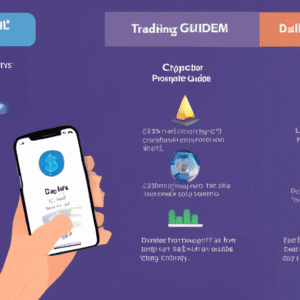Crypto Trading: A Beginner’s Guide
The world of cryptocurrency trading can seem complex and intimidating for newcomers. This beginner’s guide aims to demystify the fundamentals of crypto trading, providing you with the essential knowledge and tools to embark on your crypto trading journey.
1. Understanding the Basics of Crypto Trading
Before diving into the intricacies of trading, it’s crucial to grasp the basics of cryptocurrency itself.
What is Cryptocurrency?
Cryptocurrency is a digital form of currency that utilizes cryptography for security. It operates independently of central banks and governments, leveraging blockchain technology to ensure transparency and immutability. Bitcoin, the first and most well-known cryptocurrency, paved the way for a multitude of other digital currencies, including Ethereum, Litecoin, and countless altcoins.
How Does Crypto Trading Work?
Crypto trading involves buying and selling cryptocurrencies on specialized platforms called crypto exchanges. These exchanges facilitate the exchange of cryptocurrencies for other cryptocurrencies or fiat currencies like the US dollar. Trading pairs, such as BTC/USD or ETH/BTC, represent the exchange rate between two cryptocurrencies. Order books display buy and sell orders, providing insights into market depth. Basic order types include market orders, which execute immediately at the current market price, and limit orders, which specify a desired price for execution.
Risks and Rewards of Crypto Trading
Crypto trading offers the potential for significant returns, but it is crucial to acknowledge the inherent risks. The crypto market is known for its volatility, with prices fluctuating rapidly. While this volatility can lead to substantial profits, it also carries the risk of substantial losses. Security is another concern, with the possibility of hacks, scams, and fraudulent activities.
2. Getting Started with Crypto Trading
Once you have a foundational understanding of cryptocurrency and trading principles, you can take the necessary steps to begin your trading journey.
Choosing a Crypto Exchange
Selecting a reputable crypto exchange is paramount. Factors to consider include trading fees, security measures, reputation within the industry, and the availability of your desired cryptocurrencies. Popular exchanges such as Binance, Coinbase, and Kraken offer a wide range of cryptocurrencies and services.
Setting Up Your Trading Account
Creating a trading account typically involves a registration process that includes Know Your Customer (KYC) and Anti-Money Laundering (AML) requirements. Funding your account can be done through various methods, including bank transfers, credit cards, or deposits in other cryptocurrencies.
Developing a Crypto Trading Strategy
A well-defined trading strategy is essential for success in the crypto market. Conducting thorough research and analysis of cryptocurrencies is crucial. Common trading strategies include day trading, which involves short-term trades based on intraday price fluctuations; swing trading, which aims to capitalize on medium-term price swings; and HODLing, a long-term investment approach based on the belief that the value of a cryptocurrency will appreciate over time. Implementing risk management techniques, such as setting stop-loss orders, is crucial to protect your investments.
3. Essential Tools and Resources for Crypto Traders
To navigate the complexities of the crypto market, traders can leverage a variety of tools and resources.
Crypto Trading Charts and Technical Analysis
Technical analysis involves studying historical price data to identify patterns and trends that can inform trading decisions. Candlestick charts are widely used in technical analysis, depicting price movements over specific time intervals. Key technical indicators, such as the Relative Strength Index (RSI), Moving Average Convergence Divergence (MACD), and moving averages, provide insights into market momentum, trend strength, and potential reversals.
Fundamental Analysis of Crypto Projects
Fundamental analysis focuses on evaluating the intrinsic value of a cryptocurrency by examining its underlying technology, team, market capitalization, tokenomics, and real-world applications. Studying white papers, assessing team credentials, understanding market capitalization and token distribution, and evaluating project adoption and use cases are essential aspects of fundamental analysis.
Staying Informed About the Crypto Market
The crypto market is constantly evolving, making it essential to stay abreast of the latest news and developments. Reliable news sources, crypto aggregators, influential figures in the crypto space, and online communities provide valuable insights and perspectives.
Understanding the Basics of Crypto Trading
Before diving into the world of crypto trading, it’s essential to grasp the fundamentals of this emerging asset class. This section will cover what cryptocurrency is, how crypto trading works, and the potential risks and rewards involved.
What is Cryptocurrency?
Cryptocurrency is a digital form of money that uses cryptography for security. Unlike traditional currencies issued by central banks, cryptocurrencies operate on decentralized networks called blockchains.
Blockchain Technology: A blockchain is a distributed ledger that records all transactions across a network of computers. This makes it nearly impossible to alter or counterfeit transactions, ensuring transparency and security.
Types of Cryptocurrencies: The most well-known cryptocurrency is Bitcoin, the first and largest by market capitalization. Ethereum is another popular cryptocurrency that enables the creation of smart contracts and decentralized applications. Beyond these, thousands of altcoins exist, each with its own unique features and purposes.
How Does Crypto Trading Work?
Crypto trading involves buying and selling cryptocurrencies on dedicated platforms called crypto exchanges.
Crypto Exchanges: Exchanges act as intermediaries, connecting buyers and sellers to facilitate trading. They provide a platform to place orders, view market prices, and manage your cryptocurrency holdings.
Trading Pairs: Cryptocurrencies are traded in pairs, such as BTC/USD (Bitcoin against US dollar) or ETH/BTC (Ethereum against Bitcoin). The price of a cryptocurrency is determined by the supply and demand for that specific pair.
Order Books and Market Depth: An order book displays the current buy and sell orders for a particular trading pair. Market depth indicates the volume of buy and sell orders at various price levels, reflecting the liquidity of a particular cryptocurrency.
Basic Order Types:
- Market Order: A market order is executed immediately at the best available price in the market.
- Limit Order: A limit order allows you to set a specific price at which you are willing to buy or sell. The order will only be filled if the market price reaches your limit price.
Risks and Rewards of Crypto Trading
Crypto trading offers the potential for significant returns, but it’s crucial to be aware of the inherent risks involved.
Volatility and Its Impact: Cryptocurrency markets are known for their high volatility, meaning prices can fluctuate dramatically in short periods. While this volatility can create opportunities for profit, it also increases the risk of losses.
Potential for High Returns and Losses: The decentralized and relatively nascent nature of cryptocurrencies has led to substantial price appreciation for some, offering high potential returns for traders. However, the same factors can also lead to substantial losses, especially for inexperienced traders.
Security Considerations:
- Hacks and Scams: Crypto exchanges and individual wallets can be targets for hackers. It’s crucial to choose reputable exchanges with strong security measures and to practice safe storage practices for your cryptocurrency holdings.
- Scams: Be wary of scams and fraudulent schemes promising unrealistic returns in the crypto space. Conduct thorough research and due diligence before investing in any project or following investment advice.
Understanding these basics is crucial for anyone venturing into crypto trading. In the following sections, we’ll explore the steps involved in getting started with crypto trading, choosing an exchange, setting up an account, and developing a trading strategy.

Getting Started with Crypto Trading
So, you’re ready to dip your toes into the exciting world of crypto trading. Excellent! But before you start buying and selling digital currencies, there are a few crucial steps you need to take. This section will guide you through setting up your trading account, choosing a crypto exchange, and developing your initial trading strategy.
Choosing a Crypto Exchange
The first step is to select a reputable crypto exchange. Think of it as your marketplace for buying and selling crypto. There are many exchanges out there, each with its own pros and cons. Here are some key factors to consider when making your choice:
- Fees: Exchanges charge fees for trading, depositing, and withdrawing funds. Compare these fees carefully, as they can significantly impact your profits.
- Security: Security is paramount in the crypto world. Look for exchanges with robust security measures like two-factor authentication (2FA), cold storage for most of their assets, and a good track record of preventing hacks.
- Reputation: Read reviews and research the exchange’s history. Look for platforms known for their reliability and customer support.
- Available Cryptocurrencies: Different exchanges list different cryptocurrencies. Ensure the exchange you choose offers the coins you’re interested in trading.
Some of the most popular and well-regarded crypto exchanges include:
- Binance: Known for its wide selection of cryptocurrencies and low fees.
- Coinbase: A beginner-friendly platform with a strong reputation for security.
- Kraken: A trusted exchange with a focus on security and advanced trading features.
Setting Up Your Trading Account
Once you’ve selected an exchange, the next step is to create an account. This typically involves:
- Registration: Provide your email address, create a strong password, and agree to the exchange’s terms and conditions.
- KYC/AML Requirements: Most reputable exchanges comply with Know Your Customer (KYC) and Anti-Money Laundering (AML) regulations. You’ll need to verify your identity by providing personal information and official documentation (e.g., driver’s license or passport).
- Funding Your Account: You’ll need to deposit funds into your account to start trading. Most exchanges accept fiat currency (USD, EUR, etc.) via bank transfer or credit/debit card. Some also allow you to deposit cryptocurrencies you already own.
Developing a Crypto Trading Strategy
Before you jump into trading, it’s crucial to have a plan. This is where a trading strategy comes in. A well-defined strategy helps you make informed decisions and manage risk effectively. Here’s what you need to consider:
- Research and Analysis: Spend time researching the cryptocurrencies you’re interested in. Understand their technology, use cases, and market potential. Use technical analysis (chart patterns, indicators) and fundamental analysis (project fundamentals, team, market trends) to inform your decisions.
- Trading Styles: There are various trading styles, each with its own risk profile and time commitment:
- Day Trading: Involves making multiple trades within a single day, capitalizing on short-term price fluctuations.
- Swing Trading: Holding trades for a few days or weeks, aiming to profit from medium-term price swings.
- HODLing: A long-term strategy where you buy and hold cryptocurrencies for extended periods, believing in their long-term growth potential.
- Risk Management: Crypto markets are highly volatile. Set clear risk management rules:
- Stop-Losses: Automatically sell your position if the price drops to a certain level, limiting potential losses.
- Position Sizing: Never invest more than you can afford to lose. Determine an appropriate position size based on your risk tolerance.
Remember, successful crypto trading requires a combination of knowledge, strategy, and discipline. Start small, learn as you go, and gradually refine your trading skills.

Essential Tools and Resources for Crypto Traders
Navigating the world of crypto trading requires more than just enthusiasm; it demands a keen understanding of the tools and resources that can help you make informed decisions. From deciphering technical charts to grasping the fundamentals of a crypto project, here’s what every crypto trader should know:
Crypto Trading Charts and Technical Analysis
Technical analysis is a cornerstone of trading, involving the study of past price movements and patterns to predict future trends. For crypto trading, candlestick charts are a popular tool:
- Understanding Candlestick Charts and Patterns: Each candlestick on a chart represents a specific timeframe (e.g., one day). It visually depicts the opening, closing, high, and low prices within that period. Recognizing patterns like head and shoulders, double tops, and flags can offer insights into potential price reversals or continuations.
- Key Technical Indicators: These mathematical calculations applied to price data provide additional trading signals. Some essential indicators include:
- RSI (Relative Strength Index): Measures the magnitude of recent price changes to evaluate overbought or oversold conditions.
- MACD (Moving Average Convergence Divergence): Identifies potential buy and sell signals based on the convergence and divergence of two moving averages.
- Moving Averages: Smooth out price data to identify trends and potential support and resistance levels. Common moving averages include the 50-day, 100-day, and 200-day moving averages.
Fundamental Analysis of Crypto Projects
Unlike technical analysis, fundamental analysis delves into the intrinsic value of a cryptocurrency. This involves researching the underlying project and assessing its potential for long-term success:
- Evaluating White Papers and Team Credentials: A project’s white paper outlines its goals, technology, and roadmap. Scrutinize the team’s experience, expertise, and track record. A strong team with a well-defined vision enhances a project’s credibility.
- Understanding Market Capitalization and Tokenomics: Market cap represents the total value of all coins or tokens in circulation. Tokenomics refers to the token’s distribution, use cases, and economic model. Understanding these aspects helps gauge a project’s potential for growth and sustainability.
- Assessing Project Adoption and Use Cases: A cryptocurrency’s real-world applications and adoption rate are crucial. Evaluate how actively the project is being developed, its partnerships, and the community’s engagement. Widespread adoption suggests a higher likelihood of future value appreciation.
Staying Informed About the Crypto Market
The crypto market is dynamic and ever-changing. Staying abreast of news, trends, and expert opinions is vital for making timely and informed trading decisions:
- Reliable News Sources and Aggregators: Seek out reputable crypto news websites, blogs, and aggregators that provide accurate and timely information. Beware of misinformation and hype often found on social media.
- Following Influencers and Analysts: While taking opinions with a grain of salt, following respected crypto influencers and analysts can provide valuable insights and perspectives on market trends.
- Joining Crypto Communities and Forums: Engage with other traders and enthusiasts in online communities and forums. These platforms offer opportunities to learn, share ideas, and gain diverse viewpoints on the market.
Remember, consistent learning and research are essential for success in crypto trading. Utilize these tools and resources to deepen your understanding of the market and make well-informed trading decisions.
Conclusion
Cryptocurrency trading offers an exciting opportunity to participate in a rapidly evolving financial landscape. However, it is crucial to remember that this market is highly volatile and presents inherent risks. As a beginner, it’s essential to prioritize education, research, and a cautious approach. By understanding the fundamentals of blockchain technology, trading mechanics, and risk management, you can equip yourself with the knowledge needed to navigate this dynamic market. Starting with small investments, developing a sound trading strategy, and utilizing available tools and resources will contribute to a more informed and potentially successful trading journey. Remember, the crypto world is constantly changing, so continuous learning and adaptation are essential for staying ahead of the curve.
